Upgrading your guitar amplifier is arguably the most impactful change you can make to your guitar rig’s sound. You might possess a top-of-the-line custom guitar, a pedalboard overflowing with boutique effects, and impeccable playing skills, but without one of the Good Guitar Amps, your sound will never truly shine.
The world of guitar amplifiers is undergoing a significant transformation, largely fueled by the advancements in modeling technology. We are currently in a transitional phase where modeling amps are gaining immense popularity, while many guitarists still passionately defend their tube amps. While we believe tube amps will always hold a special place, modeling amps offer undeniable versatility and practicality for a vast majority of players. Modern modeling amps can sound remarkably similar to their tube counterparts, and their very existence is rooted in the iconic tones that tube amps have established.
In 2025, the market offers an extensive array of guitar amps, and we’ve curated a list of the very best to simplify your search. We’ve rigorously tested these amps in various settings – from home practice to rehearsal spaces and live stages – to ensure only the top performers are included. Our testing process involved using different pickup types, including single-coils, humbuckers, and P90s, as well as a diverse range of stompboxes to evaluate their performance under the demands of all types of guitarists.
Purchasing an amplifier is a significant investment, and not a decision to be taken lightly. To assist you in making the right choice, this guide provides extensive advice, including a comprehensive FAQ section and a detailed spec comparison table. So, let’s dive in and explore some of the good guitar amps that are available right now…
Our Top Picks for Good Guitar Amps
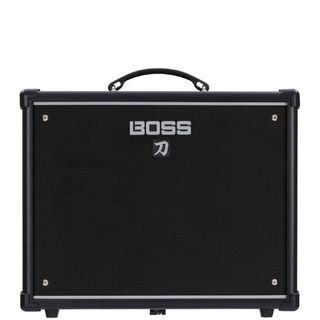 Best guitar amps: Boss Katana-50 MkII
Best guitar amps: Boss Katana-50 MkII
Best Budget
- Boss Katana-50 Gen 3
An evolution of one of the most popular modeling amps ever, the Boss Katana-50 Gen 3 delivers a brand-new amp model and studio-quality effects, offering exceptional versatility at an unbeatable price.
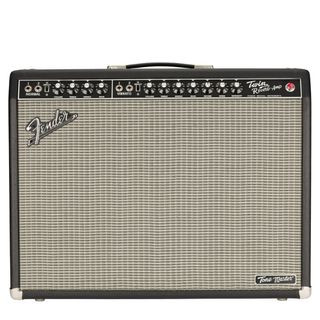 Best guitar amps: Fender Tone Master Twin Reverb
Best guitar amps: Fender Tone Master Twin Reverb
Best for Home
- Fender Tone Master Twin
The Fender Tone Master Twin Reverb, a best-seller in recent years, provides remarkably authentic tube amp tone at manageable volumes for home use.
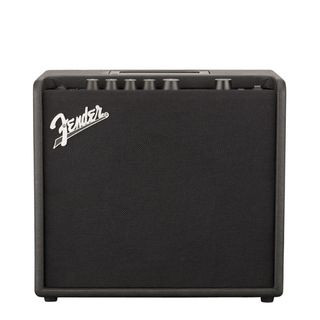 Best guitar amps: Fender Mustang LT25
Best guitar amps: Fender Mustang LT25
Best Beginner
- Fender Mustang LT25
The Fender Mustang LT25’s compact size, excellent sound, and extensive amp and effects models make it an outstanding choice for beginner guitarists, especially considering its affordable price.
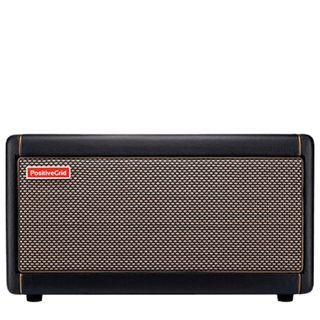 Best guitar amps: Positive Grid Spark 40
Best guitar amps: Positive Grid Spark 40
Best Practice
- Positive Grid Spark 40
For guitarists seeking their first amp or a dedicated practice amp for home, the Spark 40’s vast library of sounds delivers. It features virtually every amp model imaginable, along with a wealth of high-quality effects.
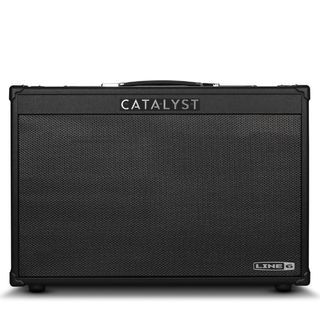 Best guitar amps: Line 6 Catalyst 200
Best guitar amps: Line 6 Catalyst 200
Best Sub-$500
- Line 6 Catalyst 200
If you need a versatile amp under $500 that can handle any situation, the Line 6 Catalyst 200 is a top contender. It provides gig-ready power, exceptional amp tones, and versatile effects, representing remarkable value.
Best Tube Amp
- Fender ’65 Deluxe Reverb
For the ultimate pedal platform amp, the Fender ’65 Deluxe Reverb stands out. Its pristine clean tone and ample headroom make it ideal for stompboxes.
Best Budget Guitar Amp
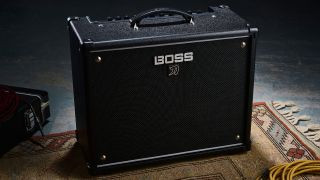 Boss Katana 50 Gen 3 guitar amplifier on a rug
Boss Katana 50 Gen 3 guitar amplifier on a rug
(Image credit: Boss)
1. Boss Katana 50 Gen 3
The Boss Katana 50 Gen 3 could be the only guitar amp you’ll ever need.
Read our expert review
Specifications
Watts: 50
Type: Solid-state with digital effects
Preamp tubes: N/A
Power amp tubes: N/A
Speakers: 1×12″
Reasons to Buy
- Extensive range of sounds
- Excellent value for the price
- Numerous high-quality effects
Reasons to Avoid
- Software required for advanced editing
- Bluetooth is an optional add-on
At a Glance
✅ Ideal if you’re on a budget: The Katana offers exceptional value, packed with excellent amp and effects models, making it one of the most popular guitar amps globally for good reason.
❌ Not ideal if you dislike software: Maximizing its potential requires using the Boss Tone Studio software, so avoid if you prefer not to deeply edit your tones via software.
For any guitarist, an amplifier that allows experimentation with diverse sounds is invaluable, and the Boss Katana 50 Gen 3 excels in this area. Beyond being a fantastic budget guitar amp, its integrated effects and connectivity make it a serious contender even for experienced players.
This latest iteration of the Boss Katana remains an excellent ‘first’ amp or reliable backup for most guitarists. With a new amp model added to its already impressive suite of Boss effects, it easily bridges the gap from practice sessions to small gigs.
Connecting the Katana modeling amp to a computer unlocks deep parameter editing, and we appreciated its direct recording capability into a digital audio workstation via USB. The two channels allow for quick recall of favorite settings, and versatile connectivity ensures seamless integration into any existing setup.
Read our comprehensive review of the Boss Katana 50 Gen 3
Best Guitar Amp for Home Use
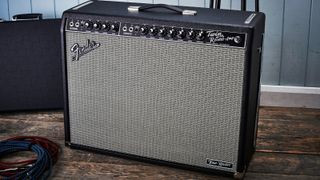 Fender Tone Master Twin Reverb guitar amplifier
Fender Tone Master Twin Reverb guitar amplifier
(Image credit: Future)
2. Fender Tone Master Twin Reverb
The legendary tone monster receives a modern update.
Read our expert review
Specifications
Watts: 200W
Type: Digital
Preamp tubes: N/A
Power amp tubes: N/A
Speakers: 2×12” Jensen N-12K
Reasons to Buy
- Abundant headroom
- Exceptionally lightweight
- Realistic tube amp tone
Reasons to Avoid
- Not a genuine tube amplifier
At a Glance
✅ Ideal if you want tube tone at home: The Tone Master Twin delivers a sound almost indistinguishable from its incredibly loud tube-powered counterpart, perfect for achieving great tube tone at lower volumes.
❌ Not ideal if you have limited space: While lighter than the original, it’s still a 2×12 amp and requires considerable space.
Many guitarists have dreamt of owning a Twin Reverb, but its weight and need for high volume often make it impractical. The Fender Tone Master Twin Reverb addresses these issues, delivering the coveted tube amp character without the heavy weight or excessive volume.
Like the original, the Tone Master Twin Reverb offers that slightly scooped, expansive clean tone at lower volume settings. As you increase the volume past the halfway point, the familiar chime of overdrive begins to emerge. Unlike a tube Twin, this model can be cranked to ten, especially when using the volume attenuation switch, making it a truly versatile amp for home and studio.
Despite being a modeling amp, it lacks extensive editing options and a companion app. However, it features a cabinet simulation that replicates the sound of a Shure SM57 or a ribbon microphone on the cabinet, a feature that will appeal to recording engineers. This is a remarkable piece of digital technology, and while its tone might not be exactly identical to a vintage Twin, it comes remarkably close.
Read our in-depth review of the Fender Tone Master Twin Reverb
Best Guitar Amp for Beginners
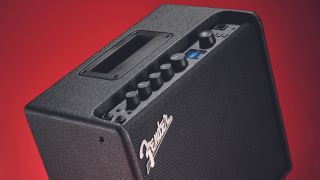 Fender Mustang LT25 guitar amplifier
Fender Mustang LT25 guitar amplifier
(Image credit: Fender)
3. Fender Mustang LT25
An exceptional value amp ideal for those just starting out.
Read our expert review
Specifications
Watts: 25W
Type: Modeling
Preamp tubes: N/A
Power amp tubes: N/A
Speakers: 1×8-inch Fender Special Design
Reasons to Buy
- Extremely user-friendly
- Wide variety of tones
- Compact and portable
Reasons to Avoid
- Other amps offer more features
At a Glance
✅ Ideal if you’re buying your first guitar amp: With numerous excellent presets, a compact size, and straightforward operation, the Mustang LT25 is perfectly suited for beginner guitar players.
❌ Not ideal if you plan to gig: At 25 watts, it lacks the power to compete with a drummer in a rehearsal or deliver sufficient volume for stage performances.
When selecting a guitar amp for beginners, ease of use and great sound quality are paramount. A modeling amp like the Fender Mustang LT25 is perfectly suited to this, offering beginners a wealth of sonic options without being overwhelming.
It comes with 30 onboard presets, providing a broad spectrum of sounds, from classic Fender cleans to high-gain metal tones. A vast selection of high-quality effects, including compressors, reverbs, delays, pitch shifters, and auto wah, helps beginners explore and develop their unique sound.
Its compact size makes it easy to transport for jam sessions, and it provides enough output to play alongside another guitarist, though it may not be loud enough to compete with a full drum kit. Combined with a very reasonable price, the Mustang LT25 is a fantastic beginner guitar amp.
Read our full review of the Fender Mustang LT25
Best Practice Guitar Amp
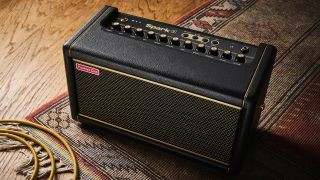 Positive Grid Spark 2 practice amplifier on a rug
Positive Grid Spark 2 practice amplifier on a rug
(Image credit: Future)
4. Positive Grid Spark 2
The smartest amp on the market becomes even more powerful.
Read our expert review
Specifications
Watts: 40
Type: Modeling
Preamp tubes: N/A
Power amp tubes: N/A
Speakers: 2×4” custom designed speakers
Reasons to Buy
- Impressive practice-oriented features
- AI Tone generation tool
- Excellent array of guitar tones
- Now includes a looper
Reasons to Avoid
- Not designed for live performances
At a Glance
✅ Ideal if you desire great tones and practice tools: The Spark 2 features an exceptional companion app that delivers fantastic sounds and incredibly useful practice features.
❌ Not ideal if you want to gig: Similar to the LT25, the Spark 2 lacks the power to compete with louder instruments in a live band setting. Look elsewhere for a gigging amplifier.
The original Positive Grid Spark revolutionized the amp market and became the preferred practice amp for guitarists globally. The Spark 2 builds upon this success, adding a highly requested looper, improved sound quality, and enhanced AI-powered practice tools.
The sound from the Spark 2 is remarkably impressive for its size, delivering massive tones. The speakers are now angled slightly outward, enhancing the fullness of the tones, particularly with stereo effects like reverb and delay. It delivers impressive realism, and our testing sessions were filled with moments of genuine delight from the modeled sounds.
Positive Grid has finally incorporated a looper, which can be controlled via your smartphone or the optional Spark Control X foot controller. It’s surprisingly user-friendly with the phone app in groove looper mode, enabling consistent looping based on rhythms rather than relying on button presses for new loops.
An AI tone generator, accessible through the Spark App, allows you to create sounds using text prompts, similar to image generation tools like Midjourney. Like all AI tools, the quality depends on the input text, but we achieved surprisingly accurate sounds based on just a few well-chosen phrases.
Read our detailed review of the Positive Grid Spark 2
Best Guitar Amp Under $500
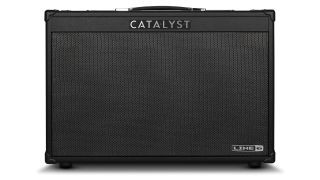 Line 6 Catalyst 200 guitar amplifier
Line 6 Catalyst 200 guitar amplifier
(Image credit: Line 6)
5. Line 6 Catalyst 200
Our top choice for a guitar amp under the $500 price point.
Read our expert review
Specifications
Watts: 200W
Type: Modeling
Preamp tubes: N/A
Power amp tubes: N/A
Speakers: 2 x 12″ Custom Design
Reasons to Buy
- Superb amp sounds
- High-quality effects
- Loud enough for gigging
Reasons to Avoid
- Effects are not the most flexible
At a Glance
✅ Ideal if you need a great value gigging amp: With ample power, this 2×12″ speaker amplifier provides serious punch and clarity in its tones.
❌ Not ideal if you prefer extensive built-in effects: It offers a fantastic selection of effects, but you can only use two simultaneously, and one must be reverb.
Positioned as a rival to the popular Boss Katana, the Line 6 Catalyst 200 is a powerful modeling amp offering numerous features for under $500. If you seek an amp that delivers quality tones and is gig-ready, it’s hard to find better value at this price.
The Catalyst 200 is based on six amp models: Clean, Boutique, Chime, Crunch, Dynamic, and High Gain, inspired by classic designs from Fender, Marshall, Vox, and others. Its two 12-inch speakers produce pristine sounds with excellent clarity and powerful output when you increase the volume.
Line 6 effects have always been highly regarded, and this amp includes an excellent selection from the HX series, featuring delay, chorus, reverb, phasers, and more. One limitation is that only two effects can be used at once, with one slot dedicated to reverb. If you prefer complex effect chains, this might be a constraint, but for players using external pedals, it’s less of an issue.
Read our detailed review of the Line 6 Catalyst 100
Best Tube Guitar Amp
 Fender guitar amplifier
Fender guitar amplifier
(Image credit: Future)
6. Fender ’65 Deluxe Reverb
An iconic amplifier that excels with pedals.
Read our expert review
Specifications
Watts: 22
Type: Tube
Preamp tubes: 4 x 12AX7, 2 X 12AT7
Power amp tubes: 2 x 6V6
Speakers: 1×12″ Jensen C12K
Reasons to Buy
- Perfect for use with pedals
- Incredible valve tone
- Authentic spring reverb
Reasons to Avoid
- Not designed for high-gain tones
At a Glance
✅ Ideal if you want the ultimate tube amp experience: One of the most recorded amps ever, the Deluxe Reverb delivers exquisite tube tones, making it a perfect pedal platform and recording amp.
❌ Not ideal if you need high gain directly from the amp: While it sounds fantastic, it won’t achieve metal-level gain like some other amps listed here.
The Fender ‘65 Deluxe Reverb, one of the most celebrated amplifiers ever, has graced countless recordings over the years. It’s an iconic amp, and while vintage models are prohibitively expensive, this reissue maintains the original mojo while remaining accessible to most guitarists seeking one of the best tube amps.
As a pedal platform, this amp is exceptional, requiring significant gain before it reaches its sweet overdrive. Its pristine clean tone is incredibly versatile, whether you’re using fuzz pedals or playing clean jazz lines. It’s also excellent for recording, as you don’t need to push it as hard as larger amps to get usable tones.
It features two channels with two inputs each, offering flexibility in shaping your sound. The tube-driven reverb and tremolo are sublime, allowing for tones ranging from subtle to spacious, making this one of the most versatile amps available.
Read our detailed review of the Fender ’65 Deluxe Reverb
Best Solid State Guitar Amp
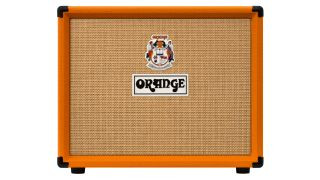 Orange Super Crush 100 guitar amplifier
Orange Super Crush 100 guitar amplifier
(Image credit: Orange)
7. Orange Super Crush 100 Combo
A superb solid-state combo offering excellent value.
Read our expert review
Specifications
Watts: 100W
Type: Solid state
Preamp tubes: N/A
Power amp tubes: N/A
Speakers: 1 x 12″ G12-K150
Reasons to Buy
- Sounds remarkably like a tube amp
- Significant headroom
- Broad range of tones
Reasons to Avoid
- Unconventional control labels
At a Glance
✅ Ideal if you want great tone without the hassle of tubes: The Crush 100 sounds as good as the tube-equipped Rockerverb it’s based on, delivering some of the best non-tube guitar tones we’ve encountered.
❌ Not ideal if you need built-in effects: It lacks onboard effects, so you’ll need a pedalboard for delays, chorus, and reverbs.
For guitarists seeking the sound of a great tube amp on a tighter budget, the Orange Super Crush 100 comes incredibly close without the expense of tubes. It utilizes a JFET preamp design combined with the same power amp found in the popular Orange Pedal Baby, producing highly realistic tube-like tones.
With two channels, it provides tones ranging from articulate cleans to metal distortion, with ample headroom to accommodate your favorite pedals. The tone is reminiscent of classic Orange Rockerverb amps, yet versatile due to its three-band EQ.
New users might find the pictorial labels on the amp controls slightly confusing, but a quick glance at the manual or a Google search quickly resolves this. The combination of channel and master controls makes this amp highly adaptable for any application, and one of the best solid state amps we’ve ever played.
Read our detailed review of the Orange Super Crush 100
Best Combo Guitar Amp
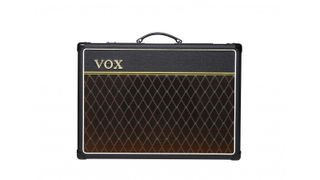 Vox AC15 C1 guitar amplifier
Vox AC15 C1 guitar amplifier
(Image credit: Vox)
8. Vox AC15 C1
The best guitar amp for vintage vibe with undeniable class.
Read our expert review
Specifications
Watts: 15
Type: Tube
Preamp tubes: 12AX7
Power amp tubes: EL84
Speakers: 12” Celestion G12M Greenback
Reasons to Buy
- Nails the iconic Vox tone
- Excellent onboard tremolo
- Great portability
Reasons to Avoid
- Not suited for high-gain enthusiasts
At a Glance
✅ Ideal if you want vintage guitar tones: This Vox delivers the classic ‘chime’ amp tone, perfect for those who love vintage tube amp sounds. The onboard tremolo is also fantastic.
❌ Not ideal if you need high gain: While it can achieve overdrive easily, it won’t reach high-gain, metal territory.
Launched over 60 years ago, the Vox AC15 is the veteran in this guide to good guitar amps. Yet, its iconic grille still attracts guitarists, drawn by the promise of one of the most recognizable tones in guitar history, used by artists from the Beatles to Brian May.
This amp offers a broad tonal range, from its signature sparkling clean to a mid-heavy, compressed overdrive. The highs are complex yet articulate, and the low-end response is punchy and dynamic, sounding equally impressive with both single-coil and humbucker guitars.
The onboard tremolo is particularly appealing, with speed and depth controls allowing you to dial in subtle warbles to more pronounced, gated effects. It also features a spring reverb with a level control, perfect for adding surf-guitar ambiance. For the best combo amps, it’s hard to surpass this one if you appreciate classic tones.
Best Guitar Amp for Metal
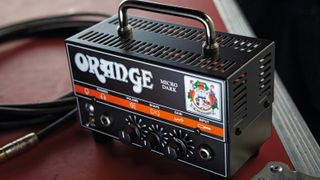 Orange Micro Dark guitar amplifier head
Orange Micro Dark guitar amplifier head
(Image credit: Future)
9. Orange Micro Dark
A micro amp with a surprisingly massive sound.
Read our expert review
Specifications
Watts: 20
Type: Hybrid
Preamp tubes: 12AX7
Power amp tubes: N/A
Speakers: N/A
Reasons to Buy
- Excellent tone options
- Compact size for gigging
- Speaker emulation output
Reasons to Avoid
- Not a full tube amp
At a Glance
✅ Ideal if you want a compact metal amp: The Micro Dark packs serious metal punch in a tiny package, making it great for gigging metal guitarists.
❌ Not ideal if you strictly prefer tube amps: This hybrid amp uses tubes only in the preamp stage, which might not satisfy tube purists.
The Orange Micro Dark is one of Orange’s most popular amps and one of the best amps for metal we’ve tested. It combines great tone with compact portability and excellent connectivity, offering incredible value and deserving a place in any guitarist’s rig.
Orange is not exaggerating with the ‘micro’ label – it’s remarkably small and weighs about the same as some practice amps. It looks tiny next to a 4×12 cabinet, yet produces a sound level that will have audiences reaching for earplugs. It delivers classic Orange midrange with a pleasing clean channel and gain that ranges from classic rock to djent.
Besides a traditional speaker output, it also includes a speaker-emulated output for direct connection to a mixing desk or home recording setup. This output also functions as a headphone out for silent practice, rounding out this brilliant amplifier’s comprehensive feature set.
Read our detailed review of the Orange Micro Dark
Best Guitar Amp for Jazz
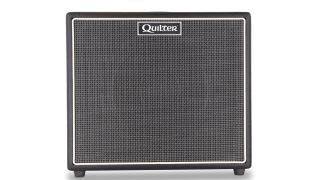 Quilter Aviator Mach 3 guitar amplifier
Quilter Aviator Mach 3 guitar amplifier
(Image credit: Quilter)
10. Quilter Aviator Mach 3 Combo
A lightweight yet powerful amp ideal for jazz tones.
Read our expert review
Specifications
Watts: 200W
Type: Solid state
Preamp tubes: N/A
Power amp tubes: N/A
Speakers: 1 x 12″ Celestion Copperback
Reasons to Buy
- Incredible clean tones
- Lightweight and portable
- Plenty of power for gigging
Reasons to Avoid
- Overdrive/distortion sounds are not its strength
At a Glance
✅ Ideal if you need loud clean tones with ample headroom: Delivering 200W, the Aviator Mach 3 provides brilliant clean tones with great versatility, making it excellent for jazz and other styles needing a clean foundation.
❌ Not ideal if you need high gain: Its built-in distortion is not its strong point, so if you require high gain directly from your amp, this might not be the best choice.
For jazz guitar, a great clean amp is essential, and while typical choices might include a Fender tube amp or Roland Jazz Chorus, we’ve selected the Quilter Aviator Mach 3 as a standout option. Its pure clean power combined with its lightweight design makes it perfect for jazz players, whether gigging or practicing.
The volume and clean headroom of the Mach 3 are exceptionally impressive. It can easily keep up with a loud drummer and perform well in big band settings. The six amp voices offer flexibility to blend in or stand out, and the Celestion speaker delivers a beautifully balanced guitar tone.
It features two identical channels, allowing you to set up slightly different amp voices or distinct clean and dirty tones, switchable via an optional footswitch. Two separate inputs allow for running two instruments through the same amp, which can be useful. It also includes quality reverb and tremolo effects. The only downside for some might be its distortion effect, suggesting the use of an overdrive pedal for dirt tones.
Best Pedal Guitar Amp
 Strymon Iridium pedal guitar amplifier
Strymon Iridium pedal guitar amplifier
(Image credit: Future)
11. Strymon Iridium
A great-sounding and user-friendly pedal amp.
Read our expert review
Specifications
Watts: N/A
Type: Digital
Preamp tubes: N/A
Power amp tubes: N/A
Speakers: N/A
Reasons to Buy
- Pedalboard-friendly size
- Three classic amp tones
- Load custom IRs
Reasons to Avoid
- Requires a 500mA power source
At a Glance
✅ Ideal if you want a pedalboard-friendly amp solution: Strymon’s popular Iridium pedal amp is perfect for pedalboards due to its compact size and intuitive controls, eliminating the need for dedicated apps or software for basic adjustments.
❌ Not ideal if you lack good monitoring: For live use, you’ll need an FRFR speaker or excellent in-ear monitoring. It might not be suitable for venues without a good PA system.
In today’s music scene, carrying a traditional guitar amp to every gig is no longer necessary. The Strymon Iridium, while not new, remains one of the best pedal amps available, thanks to its excellent sound and ease of operation.
The Iridium offers three classic amp sounds – Fender, Vox, and Marshall-inspired – easily adjustable with physical knobs on the pedal. An app is available for deeper tweaking, but users who appreciate traditional amps will find the tactile controls very appealing.
It comes with nine pre-loaded cabinet impulse responses, from 1×12 to Mesa 4×12, offering tonal flexibility. You can also load your own IRs or bypass cabinet modeling altogether. A built-in room reverb adds ambiance for an “amp-in-a-room” feel, and versatile connectivity suits most use cases.
Read our detailed review of the Strymon Iridium
Best Guitar Amp Modeler
 Neural DSP Quad Cortex amp modeler
Neural DSP Quad Cortex amp modeler
(Image credit: Future)
12. Neural DSP Quad Cortex
One of the most powerful amp and effects modelers ever created.
Read our expert review
Specifications
Watts: N/A
Type: Digital
Preamp tubes: N/A
Power amp tubes: N/A
Speakers: N/A
Reasons to Buy
- Limitless array of tones
- Large and clear display
- Portable yet robust
Reasons to Avoid
- May be too complex for some users
At a Glance
✅ Ideal if you want to replace your amp entirely: The Neural DSP Quad Cortex is more than a multi-effects pedal; it can replace your entire rig, from amp to cabinet to pedalboard.
❌ Not ideal if you dislike tweaking: Maximizing its potential requires time for setup and tone tweaking. It’s best avoided if you’re not comfortable with technology or software.
Neural DSP’s Quad Cortex is among the best amp modelers we’ve ever used, and it’s capable of much more. It can capture amp and pedal tones and function as an audio interface, making it not just a replacement for a traditional amp, but a whole new approach to your rig.
The sheer variety of available sounds is astounding. It features almost every amp imaginable, all captured with pristine realism. Furthermore, you can model your existing rig into the unit, ensuring your signature sound remains consistent wherever you play.
The large LCD display is excellent, making patch changes and tweaks easy. The footswitches that double as rotary controls are innovative and have been adopted by other manufacturers. Connectivity is extensive, covering every scenario, whether you want a hybrid amp and modeler setup, use it for recording, or replace your live rig entirely.
Read our detailed review of the Neural DSP Quad Cortex
Spec Comparison of Good Guitar Amps
Swipe to scroll horizontally
| Amp | Type | Watts | Speaker |
|---|---|---|---|
| Boss Katana 50 Gen 3 | Modeling | 50 | 1×12″ |
| Fender Tone Master Twin Reverb | Modeling | 200 | 2×12″ |
| Fender Mustang LT25 | Modeling | 25 | 1×8″ |
| Positive Grid Spark 2 | Modeling | 50 | 2×4″ |
| Line 6 Catalyst 200 | Modeling | 200 | 2×12″ |
| Fender ’65 Deluxe Reverb | Tube | 22 | 1×12″ |
| Orange Super Crush 100 | Solid State | 100 | 1×12″ |
| Vox AC15 C1 | Tube | 15 | 1×12″ |
| Orange Micro Dark | Hybrid head | 20 | N/A |
| Quilter Aviator Mach 3 | Solid State | 200 | 1×12″ |
| Strymon Iridium | Modeling | N/A | N/A |
| Neural DSP Quad Cortex | Modeling | N/A | N/A |
Other Good Guitar Amps to Consider
The guitar amps listed above represent our top recommendations. However, various needs exist in guitar amplification, so if you haven’t found your perfect match, here are more highly-rated options.
PRS MT15 Mark Tremonti Tube head | 15W | JJ EC83S, 6L6
The MT 15 follows the lunchbox amp design, featuring two channels and switchable output power, making it ideal for practice, recording, and small gigs. It’s clearly aimed at higher gain fans, with 6L6 power tubes delivering ample saturation. ★★★★½
Read more: PRS MT15 Mark Tremonti review
 Marshall DSL40CR Tube combo | 40W | 4 x ECC83, 2 x EL34 | 1×12” Celestion V-Type½
Marshall DSL40CR Tube combo | 40W | 4 x ECC83, 2 x EL34 | 1×12” Celestion V-Type½
Marshall DSL40CR Tube combo | 40W | 4 x ECC83, 2 x EL34 | 1×12” Celestion V-Type
The Marshall DSL40CR aims to provide the classic Marshall 4×12 sound in a more manageable format. Tonally versatile and portable, the DSL40CR is an all-tube amp offering excellent value for gigging guitarists. ★★★★½
Read more: Marshall DSL40CR review
Blackstar HT Club 40 Tube combo | 40W | ECC83, EL34 | 1x 12” Celestion
The Blackstar HT Club 40 has been a standard for mid-priced tube amps due to its footswitchable voices, offering American and British-leaning tones, essentially giving you four amp tones in one. ★★★★½
Read more: Blackstar HT Club 40 review
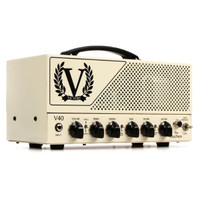 Victory V40 The DuchessTube head | 40W | 12AX7, EL34
Victory V40 The DuchessTube head | 40W | 12AX7, EL34
Victory V40 The Duchess Tube head | 40W | 12AX7, EL34
Despite its compact size, the Victory V40 can produce significant volume. It’s a 40-watt, single-channel tube head capable of both US and UK style tones, and its substantial clean headroom makes it an exceptional pedal platform. ★★★★★
Read more: Victory V40 The Duchess review
Buying Advice for Good Guitar Amps
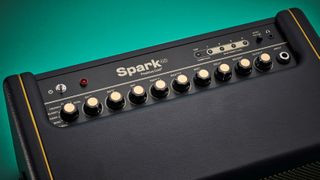 Best guitar amps: Positive Grid Spark image
Best guitar amps: Positive Grid Spark image
(Image credit: Future)
Guitar amplification fundamentally relies on three components: preamp, power amp, and speaker. The preamp shapes the tone, the power amp amplifies it to drive the speaker, and the speaker projects the sound.
Tube, Solid State, or Digital Amp?
The primary decision is whether to choose a tube, solid-state, or digital amp modeler. Tube amps offer a unique, dynamic response due to the physical reactions within vacuum tubes. They provide a rich harmonic warmth and responsiveness that many guitarists still prefer, despite digital advancements. When pushing a tube amp’s power section at stage volumes, tubes truly excel in a way that digital and modeling amps struggle to replicate fully.
Modeling amps excel in versatility and immediate gratification. Modern modeling amps can accurately recreate hundreds of amp models across genres, offering a vast tonal palette. They also often include cabinet and speaker simulations and a wide array of built-in effects, making them ideal for cover bands needing diverse sounds and beginners exploring their tonal preferences.
The distinction between solid-state and modeling amps has blurred recently, but solid-state amps generally don’t emulate multiple amp types like modelers. Despite some tonal purists’ skepticism, Class D power amps are compact and efficient, often leaning towards cleaner tones. This makes them excellent pedalboard-friendly amps, though their overdriven and distorted tones may not match high-end modelers or tube amps.
Combo or Head?
Combo amps integrate the preamp, power amp, and speakers into one unit, while heads require external speakers. Heads offer the advantage of using different speaker configurations, but with noise restrictions at venues and improved PA systems even in smaller venues, the need for extreme volume is less critical. Using heads on the road without your own cabinet also means relying on potentially inconsistent venue-provided cabinets.
Combo amps are ideal for consistent sound portability. You can rely on your carefully crafted sound being delivered as intended at each gig. However, combo amps are often heavier, which can be a drawback for transport.
Guitar Amp Wattage: Does it Matter?
Yes, wattage is important. Generally, higher wattage means greater volume. However, tube amps sound perceptibly louder than solid-state or modeling amps of the same wattage due to complex electrical characteristics. A 10-15 watt tube amp can often match the perceived loudness of a 50-watt digital amp. Consider this when choosing between a high-wattage tube head and a combo.
Gain Requirements for Your Guitar Amp
Consider your gain needs. If you use a pedalboard with overdrive and distortion pedals, you might prefer a clean amp platform. However, for heavier genres, high-gain amps offer a richer, more three-dimensional distortion than many pedals. Also, consider the number of channels if you need to switch between clean and distorted tones quickly.
How We Test Good Guitar Amps
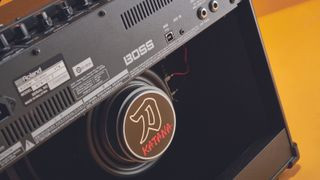 Close up of the speaker on a Boss Katana 50 modeling amplifier
Close up of the speaker on a Boss Katana 50 modeling amplifier
(Image credit: Future)
Our amp testing process is comprehensive and tailored to the amp’s intended use. While testing methods vary depending on whether an amp is designed for stage or home use, build quality remains a constant priority.
We assess build quality first. All amps, regardless of application, should be well-constructed and robust. Guitar amps should feel durable and capable of withstanding regular use, with smooth, responsive controls.
For tonal evaluation, we begin with all settings at their midpoint to hear the amp’s inherent sound. We then adjust settings to shape the sound to our preferences, paying close attention to the EQ controls. We test the amp across its gain spectrum, from maximum saturation to pristine clean tones.
For amps with additional features like effects or attenuators, we thoroughly test each function to ensure comprehensive evaluation.
Learn more about our rating system, gear selection process, and detailed testing methods.

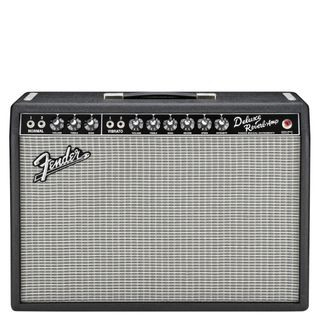 Best guitar amps: Fender
Best guitar amps: Fender